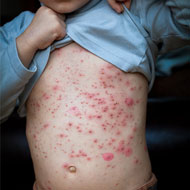Toddler Foot Rash Symptoms, Causes, and Treatment
It is very common for a toddler’s body to break into rashes. There are common problems like impetigo, eczema, or dermatitis that can affect the legs, hands, face, and other body parts of your child. Toddler rash on the legs is however particularly common.
These rashes may sometimes be difficult to treat, especially because a toddler’s skin is sensitive. However, these rashes need to be controlled and treated as soon as possible as they can spread to other body parts easily too. It’s very important that your toddler does not scratch the itchy parts to avoid secondary infections and to also prevent the rash from spreading.
Symptoms for Foot Rash on Toddlers
Symptoms for toddler rashes caused by any problem are usually the same. The affected skin breaks into tiny bumps, there is an itching and burning sensation on the area, the skin also becomes warm, dried and cracked. These rashes also tend to worsen in dry weather.
Causes for Foot Rash on Toddlers
Most skin rashes are caused by fungal, viral and bacterial infections. Rashes are often also caused by allergies to foods, plants, animals or insect bites. Viral infections are the most common kind of rashes and they usually resolve sooner on later on their own. If the toddler has eczema, one of the primary reasons for the rash could be heredity – there is no other known cause for this condition.
Treatment for Foot Rash on Toddlers
There are many products that can be used to treat rash in toddlers. However, it would be better to ensure that the toddler’s skin is not sensitive to the ingredients in these products. One of the remedies to get rid of the rash on a toddler’s leg or any other affected part is rubbing a paste of sandalwood powder and rose water every night.
Aloe vera gel is also very effective in treating the rashes. To heal the skin and alleviate itching and pain, you can also break open capsules of Vitamin E and rub the oil obtained from it into the affected skin.
Applying olive oil or coconut oil singly or mixing either with two drops of tea tree oil and applying will also get rid of the rash. It’s very important to keep your child’s skin clean. A good cleansing process would be swabbing the affected skin with chamomile tea. It would be beneficial if the house is free of dust mites as these can aggravate an already existing rash. There are many antifungal creams and lotions available that can also be used to treat the problem. Rashes have a tendency to recur so care needs to be taken after the treatment as well.


